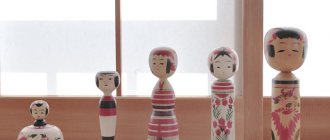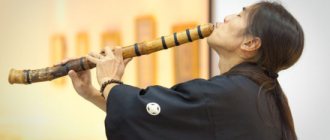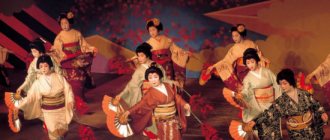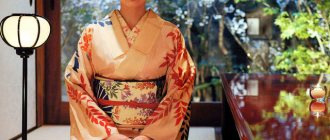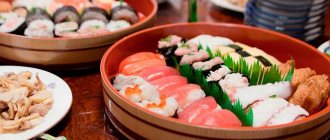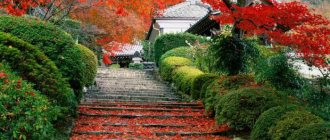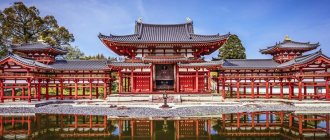Ninge
All traditional dolls in Japan are called ninge. This word is made up of two kanji 人形, which mean "person" and "form". Therefore, literally translated, Japanese dolls are called “human form”.
There are many types of dolls in the Land of the Rising Sun. Some depict children, others the imperial family and courtiers, and others depict fairy-tale characters, warriors or demons. Most of the dolls are made for traditional Japanese holidays or for gifts. Some are made specifically for tourists, as souvenirs.
Initially, Japanese dolls were created to protect the home and family from serious illnesses, curses and evil spirits. But today they have largely lost their mystical spirit, turning into exquisite pieces of art.
Kokeshi dolls – tradition and modernity
Kokeshi dolls are produced in many hot spring towns in the Tohoku region, and they appeared in the second half of the Edo period (1603-1868), when artisans who produced wooden bowls and trays on horizontal lathes, reminiscent of a potter's wheel, began to make children's toys from scrap wood . Kokeshi were initially quite small to make it easier for children to hold them in their hands, but when kokeshi began to be sold as souvenirs to those coming for treatment at the hot springs, the dolls became quite popular, and in villages with thermal baths they began to produce dolls of various sizes and shapes, decorating them in local style.
Large dolls decorate the street in Naruko-onsen, one of the centers of kokeshi production.
A master making kokeshi in the Sakurai Kokeshi workshop. Here visitors can try to paint their own doll
The first Japanese magazine dedicated to kokeshi, published in the early years of Showa (1926-1989), advertised the dolls as traditional crafts and works of art, and they were very popular at the time. The next kokeshi boom followed during the booming economic years of the late 1960s, when people flocked to Tohoku hot springs and brought back kokeshi as souvenirs.
Currently, kokeshi are experiencing another wave of popularity, mainly thanks to young women - the so-called kokeshi joshi, "kokeshi girls", are actively searching for traditional dolls, as well as collecting items from new creative art forms. The most popular new varieties include kokeshi with a three-dimensional o-kappa hairstyle; Kokeshi in the form of animals or anime characters are also common.
Kokeshi Miyagi Zao Museum in Togatta Onsen. Similar establishments displaying kokeshi can be found throughout the Tohoku region.
The kokeshi theme is found on all kinds of souvenirs
The most striking recent version is the kokeshi plane, created in 2015. Described as "strange but funny", he has been officially recognized as the kokeshi of the Miyagi Prefectural Department of Tourism and has appeared several times on posters promoting local airlines.
Thanks to the influx of visitors from abroad, kokeshi have gained popularity outside Japan, especially in Europe, where more and more people are collecting them, appreciating the simplicity of the lines and the characteristic Japanese motifs.
Kokeshi plane at the Miyagi Prefectural Administration Building
First samples
The first dolls appeared in Japan more than 10 thousand years ago. These were simple amulets. For a long time they did not change their shape, only in the Kofun era (300-710 AD) large clay monuments of warriors and animals began to appear, which were installed on graves as monuments, which simultaneously served as guards.
Dolls turned into toys in the Heian era - 784-1185. During the Edo era, doll making began to be considered a real art. This time was marked by the creation of ninge of different forms and purposes.
In 1936, Japanese dolls received the status of officially recognized art. Since 1955, every spring, selected ninge craftsmen can receive the honorary title of "Living National Treasure."
Sacrificed
In the process of development of the doll industry, ninge began to be used in a variety of areas of human activity. At one time they were used to remove the evil eye and were sacrificed instead of animals. It was believed that if the monk performed the ritual correctly, the doll would become as powerful a victim as the animal, and in some cases even better.
To carry out rituals involving sacrifice, dolls were made in the shape of a person, not an animal. The ritual itself consisted of simple manipulation: the priest tied a curse or illness to a figurine that stood in for a person. It was believed that ritual dolls had a soul, so it was unthinkable to throw them away. Ninge, who received the disease from a person, was burned or drowned in the river.
At a time when such rituals were extremely popular, many stories were invented about vengeful dolls that had their own will and were endowed with great power. Such warning stories acted as a kind of guarantee that the ritual would be carried out to the end. Those who were lucky enough to take part in such an event and hear first-hand terrible stories about living nings began to realize that these were not toys. Japanese dolls are indeed ritual attributes.
Materials and varieties
Wood, clay, paper, natural fabrics and even live chrysanthemums are often used to create dolls. Although today ninge are a common cultural heritage, some Japanese sincerely believe that the right dolls will help improve health, bring wealth and protect from harm. Japanese dolls can hardly be called simple; they are expensive, and in homes they stand in a place of honor - in the red corner (this is a kind of sanctuary for spirits).
Traditional Japanese dolls come in different types:
- Hina-ninge.
- Gogatsu-ninge.
- Karakuri-ninge.
- Gose-ninge.
- Kimekomi-ninge.
- Hakata-ninge.
- Kokeshi.
- Daruma.
- Kiku-ninge.
Bibliography:
1. Andrianova O. Sculptural textiles / O. Andrianova. - M., 2005 (Series “Secrets of Puppetry”).
– P. 23.
2. Bersteneva E. Doll chest / E.V. Bersteneva, N.V. Dogaeva. - M.: “White City”, 2013. – 112 p. – P. 10.
3. Hartman S. Japanese art / S. Hartman. St. Petersburg, 1908. - 104 p. – P. 24.
4. Goldovsky B.P. Art dolls. Large illustrated encyclopedia / B.P. Goldovsky. — Publisher: Design House, 2009. — 296 p. – P. 12.
5. Zbykovskaya N. Japanese dolls. History and traditions [Electronic resource]
– Access mode: https://fentazy 2.narod.ru (date of access –
November 2, 2015)
6. Kuzhel Yu.L. History of Japanese dolls [Electronic resource].
– Access mode: https://ochendaje.livejournal.com/ (access date –
November 2, 2015)
7. Dolls // Japan from A to Z. Popular illustrated encyclopedia. (CD-ROM).
- M.: Directmedia Publishing, “Japan Today”, 2008.
Lotman Yu. About art / Yu.M. Lotman. - St. Petersburg, 2000. – P.645-646.
9. Romanova A. Doll as an image of a person in the philosophical and worldview system / A.V. Romanova // Days of St. Petersburg Philosophy - 2005: Forum materials. St. Petersburg: St. Petersburg State University, 2005. pp. 56-58.
10. Romanova A. Traditions and modernity. Lectures for the training course “Dolls in the cultural system” / A.V. Romanova. - St. Petersburg: SPbGHPA im. A.L. Stieglitz, 2009. - 23 p.
11. Sei-Syonagon. Notes at the head. Foreword by Vera Markova / Sei Shonagon. - M.: EKSMO, 2007. - 528 p.
12. Traditional Japanese dolls [Electronic resource].
– Access mode: https://www.museum.ru/ (date of access –
November 2, 2015)
13. Traditional toys of the peoples of Japan [Electronic resource].
– Access mode: https://dreamworlds.ru/ (date of access –
November 2, 2015)
14. Traditional Japanese dolls. Japanese blog “Rock Garden” [Electronic resource].
– Access mode: https://blog-japan.ru/ (Date of access –
November 2, 2015)
15. Japanese traditional dolls. History of the country in dolls and destinies [Electronic resource].
– Access mode: https://ortos.jimdo.com (access date –
November 2, 2015)
bibliography
Similar works
Japanese traditional dolls 3
Japanese traditional dolls 2
The use of electronic resources when translating military-technical texts from Russian into English.
Semiotics of Japanese traditional kimono costume.
Electronic resources of university libraries as an integral part of the information and educational environment of a modern higher educational institution (for example
Technology of acquiring libraries with electronic resources
Corporate culture of middle-class hotel enterprises as a management resource
Political regime in modern Russia: features of evolution and prospects for functioning
Wooden figures
In Japan, dolls are more than just fun. This is a whole world that has its own history, religion and aesthetics. So, for the most part they are intended for adults.
For several centuries in Japan, there have been wooden dolls that represent a painted cone-shaped figure with a large head. These are Japanese Kokeshi dolls (in another pronunciation Kokeshi).
They are completely covered with elegant ornaments and consist of a cylindrical body and a disproportionately large head. There are cases when such a doll is carved from a single piece of wood, but this is an exception to the rule.
Such dolls are characterized by the absence of arms and legs. Today Kokeshi is a popular souvenir product; every self-respecting tourist will definitely take one of these home.
Japanese doll
Japanese traditional dolls are more than children's delights, they are true works of art with their own aesthetics, faith and vision. In Japan, dolls occupied a special position; they have always been toys that serve as religious symbols. The first dolls found in Japan were made of clay, stone and bone. Dolls served as amulets for people, played the role of talismans, protectors from illnesses and evil spirits, and were also used as guardians of the dead.
During the period 784-1185. dolls began to be made and used for play purposes. They were mainly played by girls who were freed from any work. Until they got married, with the help of numerous collections of dolls, where there were representatives of different segments of the population from monarchs to simple peasants, as well as miniature palaces and poor huts, they acted out scenes and performances.
Japanese dolls are divided into categories:
1. Figurines for festive events:
- Hina-ningyo are dolls depicting high-ranking officials.
- Gogatsu-ningyo - dolls in the form of heroes.
2. Figures with built-in mechanics - Karakuri-ningyo. The movement of these dolls is carried out by means of pouring liquid, pouring bulk materials, hot fumes, and clock mechanisms. They participated in theatrical performances, games at home, and religious ceremonies. The puppeteers kept the process of making dolls secret, and passed on their manufacturing skills only orally to those worthy.
3. Palace figurines - Gosho-ningyo. A figurine made of wood and covered with oyster shells, previously crushed using a special tool. She looks like a little chubby baby. She was a talisman for travelers.
4. Wooden figures covered with fabric - Kimekomi-ningyo. Their production is associated with the Kamo Temple, where in the 18th century monks made various souvenirs for sale.
5. Ceramic figurines - Hakata-ningyo. Made by the authors in a single copy.
6. Carved wooden dolls with bright paintings - Kokeshi. They have a cylindrical body with a head, but without arms and legs. The doll is very similar to a matryoshka doll. Today, Kokeshi are made as souvenirs for tourists.
7. Tumbler - Daruma - a figurine without limbs.
8. Modern dolls:
- LoveDolls are realistic and detailed doll models.
- Pullip are collectible dolls made of polymer material. A distinctive feature of this series of dolls is a movable body on hinges, the presence of a mechanism in the head with which the gases open and close, the position of the gaze changes, and the dolls’ hair can also be changed, i.e. hairstyle by replacing one wig with another.
- Kiku-ningyo are dolls made from fresh flowers (chrysanthemums). Bamboo frames are used to create them. Several masters work on works of art at once.
You can play with Japanese traditional dolls, but most often they are used as souvenirs. Japanese traditional dolls are suitable for role-playing games. The child can come up with different stories and act out scenes with soft toys. By playing role-playing games, the child’s personality develops, the development of his cognitive processes is activated, and the foundations are laid for mastering new, more complex types of activities. While playing, kids reflect in the roles they try on themselves everything they see around them: events, adult behavior patterns, etc. Participation in role-playing games allows you to feel like part of a team.
In the 30s of our century in Japan, doll making was recognized as one of the art forms. And in the 50s, the best puppet masters were awarded government awards. Currently, the largest collection of Japanese dolls is in the Yokohama Museum, as well as among private collectors in America and France.
Today, Japanese traditional dolls are made by hand by master craftsmen. There is no mass factory production of this toy, which is why it is valuable. Now Japanese craftsmen make traditional Kokeshi-ningyo and creative Kokeshi-ningyo. Traditional Kokeshi is produced in six prefectures in the Tohoku region. There are twelve schools of design, experts will tell you exactly where the dolls were made and often by whom.
Japanese tumblers
Another type of Japanese doll is Daruma, or tumbler doll. But this is only for us, tumblers are considered fun entertainment for children under seven years old. In Japan, Daruma is an artifact with which the inhabitants of the country perform rituals to fulfill wishes. In Japanese mythology, Daruma is considered the personification of a deity who brings happiness.
To make your wish come true, you need to go to the temple on New Year’s Eve and buy a Daruma doll there. Afterwards you need to make a wish and write it on one of the eyes, and the owner writes his name on the doll’s chin. Throughout the year, this Daruma should be kept in the most visible place in the house; you can place it on the home altar - butsudan.
If a wish comes true within a year, then a second eye is added to the doll, and if nothing changes, then you need to take Daruma to the temple where it was purchased, burn it and buy a new one. Burning a doll on the temple grounds is a symbol of purification, and means that a person does not give up his goals, but is looking for new ways to achieve them.
What is a Daruma doll (だるま)?
Japan is known for its charming characters with unique and sometimes centuries-old stories. And some have entered the Western consciousness more powerfully than the katana in the samurai. Such as many anime characters and heroes. However, the squat little bearded red tumbler dolls known as daruma have not yet found their way west. Daruma doll is also known as Dharma doll. Its design is rich in symbolism and the Japanese consider it associated with good luck. The custom of drawing eyes is associated with the Daruma doll.
These peculiar dolls, usually painted red, less often green or white, with large round eyes and missing pupils, are one of the most important mascots in Japan. There is no better way to learn the history of magical daruma than to start at the source.
Shorinzan Darumaji Temple
From Daruma (Bodaidaruma) is the Japanese pronunciation of the name Bodhidharma (?-528), the founder of the Chan (Zen) Buddhist school.
Shorinzan Darumaji Temple in Takasaki, Japan is likely where the concept of Daruma was first conceived over 300 years ago. The Daruma doll depicts the Buddhist monk Bodhidharma. Today, more than 80% of Daruma dolls in Japan are still made in Takasaki. At the temple, guests can purchase their own unique papier-mâché Daruma doll. When the doll is first purchased, it has two large empty eyes. The buyer must make a wish and then add a pupil to one of Daruma's eyes. The name of its owner is often painted on the chin of the daruma. The doll is kept in the best place in the house, often at the altar. After the desire is fulfilled, you can add a second pupil.
Daruma dolls
The Shorinzan Darumaji Temple is decorated with hundreds of Daruma stacked on top of each other in a colorful disarray. Although the traditional color of Daruma is red, there are also a variety of colors ranging from black to yellow. To the left of the temple is a small room that serves as a small museum and displays interesting non-traditional darumas. The area around the temple is well maintained and looks magical, definitely worth a stroll through the park.
At the end of the year, unfulfilled one-eyed Daruma dolls are returned to the temple for a traditional burning ceremony and the purchase of a new doll. This ceremony is called Daruma Kuyo (だるま供養). It symbolizes perseverance and determination in achieving the goal next year, so that the kami understand that the one who made the wish has not given up on his desire.
From Tokyo to Shorinzan Darumaji Temple
Take a Shinkansen ticket from Tokyo to Takasaki. At Takasaki, transfer to the JR Shinetsu Line for Yokokawa. Get off at Gunma Yawata Station. Shorinzan Darumaji Temple is about 20 minutes' walk from the station. If you're in Japan in January, consider visiting the temple during Daruma-Ichi, the official Daruma fair, which usually takes place around January 6th and 7th.
Views: 1,714
Share link:
- Tweet
- Share posts on Tumblr
- Telegram
- More
- by email
- Seal
Liked this:
Like
Similar
Japanese dolls for girls
Since the 17th century, Japan has annually celebrated Hinamatsuri “Girls' Day,” or the so-called Japanese Doll Festival. This holiday is considered one of the main ones in Japan; it is celebrated on March 3.
In ancient times, this event had a more mystical meaning: girls and young women sent paper ninges down the river, which were supposed to take misfortunes and illnesses with them.
Today this holiday has been preserved only in a few places. On the day of the holiday, girls and women in beautiful, elegant kimonos, as well as their parents, gather on the banks of the rivers closest to the city and float flat, round wicker baskets down the river, containing several paper Nagashi-bina dolls.
The founder of this holiday was Emperor Yoshimune, who had many daughters. At first, the court nobility followed his example, then all the rich people of that time began to hold such an event, and after that the whole country began to do so.
Modern Hinamatsuri
Today, on this holiday, families with daughters organize an exhibition of dolls - “khina” - in their house. A multi-tiered staircase – hinakajiri – is installed in the house, which is covered with red cloth. These steps symbolically represent the tiers of court life. On the top step is the imperial couple. These dolls are very expensive, since the clothes are made to order from high-quality materials, and the empress is dressed in 12 kimonos, as is the case in reality.
On the level below are the court ladies-in-waiting, who hold items for serving sake in their hands. Even lower down, the palace guards are stationed, and below them stand the court musicians. After the musicians, the ministers are brought out, and the servants stand on the lowest tier.
Purchase and legacy
These dolls are passed down through the family on the maternal side, and they begin to be displayed in the first year after the birth of a girl. During the holiday, the child can not only admire the home doll exhibition, but also play with them. There is also a belief that if the dolls are not removed within three days after the holiday, then the daughters will not be able to get married for a long time.
A complete set consists of 15 dolls, sometimes another tier is made on which household items, that is, doll furniture, are displayed. The staircase itself is richly decorated with lanterns and flowers, in addition to dolls, screens and tiny trees are placed on the shelves. All decorations are purchased at a special fair; a full set of Hina dolls costs about 10 thousand euros. If the family does not have enough money to buy dolls, they can be replaced with paper counterparts.
Other dolls
In addition to those already presented, there are other types of dolls. Gogatsu-ninge or May dolls are an essential part of Tango no Sekku, or Children's Day. These dolls depict samurai in full armor, historical characters, heroes of epics, folklore, tigers and horses.
Karikuri-ninge are mechanical dolls. Gose-ninge are small Japanese dolls depicting fat-cheeked children. They are carved from wood and coated with a compound made from oyster shells. Craftsmen at the imperial court were the first to make them, hence the name - palace dolls. Gose-ninge are considered talismans for travelers.
Kimekomi are wooden dolls completely covered with fabric. The first Kimekomi appeared in the Kamo Temple (Kyoto), then at the beginning of the 17th century, monks made souvenirs for sale. The first dolls were carved from wood, modern Kimekomi are made from wood-glue mass.
Special cuts are made on the body of the figurine, where the edges of the fabric are tucked, hence the name: “komi” - to tuck, “kime” - wooden edge.
Traditional Japanese dolls.
Today we will talk again about Japanese dolls. And here is information about them:
Japanese traditional dolls or "ningyo", which means "doll" in Japanese, is written in Japanese using the characters and, which mean "person" and "shape" respectively. There are many types of Japanese dolls, some of them depict children, others depict the imperial court, warriors and heroes, fairy tale characters, gods and demons. Most dolls are made for ordinary gifts or for holidays such as Hinamatsuri - Girls' Day. Other dolls are made to be sold as souvenirs to tourists. The most ancient dolls found during excavations were attributed to the Jomon period. Initially, dolls acted as amulets or talismans. The art of doll making flourished during the Edo era. Starting from this period, dolls of various shapes and purposes began to be made. Since 1936, the art of doll making has received officially recognized status in Japan. Every spring since 1955, the best doll makers can be awarded the title "National Living Treasure" (ningen kokuho) by the Japanese government. The materials for making Japanese dolls are wood, paper, fabric, clay or even live chrysanthemums. Types of Japanese dolls Hina-ningyo - dolls for the Hinamatsuri holiday, depicting the imperial family. These dolls are very valuable, they are made from expensive materials, and in Japanese families they are inherited. Gogatsu-ningyo (literally May dolls) or musha-ningyo are dolls for the Tango no Sekku holiday (now Children's Day). Often these are images of samurai in armor, historical characters (Emperor Jimmu, Empress Jingu), heroes of the Japanese epic (Momotaro), as well as figurines of tigers and horses. Karakuri-ningyo - mechanical dolls. Gosho-ningyo are small figurines in the form of thick-cheeked children, carved from wood and covered with a special composition of crushed oyster shells - “gofun”. Initially, these dolls were made by masters of the imperial court, hence their name - “palace dolls”. Gosho-ningyo is often given as a talisman before a long journey. Kimekomi-ningyo are wooden dolls covered with fabric. The origin of this type of doll is associated with the Kamo Temple in Kyoto, where at the beginning of the 18th century monks made amulets and souvenirs for sale. Modern kimekomi-ningyo are made from wood glue, unlike earlier dolls that were simply carved from wood. The most commonly used wood is paulownia. Special cuts are made on the doll's body, into which the edges of the fabric are then tucked (translated from Japanese kime - wooden edge, komi - tuck). Hakata-ningyo - ceramic dolls. The first such figurines, according to one legend, were made in Fukuoka Prefecture from the beginning of the 17th century. In 1900, Hakata dolls were exhibited at the Paris Exhibition. In 1924, Hakata dolls depicting three dancing girls won a silver award at the Paris International Fair. Kokeshi are dolls carved from wood and painted. Daruma is a tumbler doll. Kiku-ningyo - dolls made from living chrysanthemums. They consist of a bamboo frame on which chrysanthemums with small flowers dug out of the ground with roots are fixed. To prevent chrysanthemums from withering longer, their roots are wrapped in moss. The height of such dolls is approximately equal to human height. The face, hands and other parts of the dolls are made of papier-mâché. Many of these dolls are made for traditional exhibitions in the cities of Nihonmatsu and Hirakata, which are held every autumn during the chrysanthemum blooming period.
Hakata and Kiku-ninge
Hakata-ninge are dolls made from ceramics. According to legend, the first such figurines appeared in Fukuoka Prefecture. In 1900, these dolls were presented at the Paris Exhibition. In 1924, Hakata-ning, depicting three dancing girls, received a silver award at the International Paris Fair.
And the most interesting work of Kiku-ninge puppetry is figurines made from living chrysanthemums.
They consist of a bamboo base on which chrysanthemums with small flowers dug out with roots are attached. To make such a work pleasing to the eye longer, the roots of chrysanthemums are wrapped in moss. The height of Kiku-ninge is equal to human height, the face and hands for the flower figure are made of papier-mâché. Every autumn, during the chrysanthemum flowering season, such dolls can be seen at traditional exhibitions in the cities of Hirakata and Nihonmatsu.
Ninghe is a separate universe with a rich history and diverse traditions. The photos of Japanese dolls that are presented in the article are not able to convey all their splendor. But even so, it is clear that these are not just toys, but real works of art.
Traditional Japanese dolls and the modern Japanese toy industry
I recently returned from Tokyo, where I took part in the international exhibition of designer toys Fantanima 2021 with my works. A sea of impressions, another world, other people, another culture! A very unusual exhibition, not at all like Russian or European ones.
Today I want to talk about traditional Japanese dolls and the modern Japanese toy industry, I think it will be interesting to compare, since dolls play a very important role in Japanese culture.
The art of making dolls in Japan has the status of a full-fledged form of creativity, along with fine art. Everything is serious! Dolls have always been very important for the Japanese, and puppeteers have been respected for a long time.
So, in Tokyo, my hotel was located between two areas: Akihabara and Asakusabashi. Both are somehow related to toys, and I didn’t choose this place on purpose! Although, I have ceased to be surprised by such non-random coincidences
Asakusabashi is considered an old district and is home to shops selling traditional Japanese dolls and handicraft shops.
Traditional Japanese “ningyo” dolls are made for holidays (for example, Hinamatsuri - a girl’s holiday), or as souvenirs (for example, “Daruma”, which can be bought in any souvenir shop and, after drawing one eye, make a wish, he receives the second eye , when a wish comes true. Cruel, but fair, I think).
While walking around the shops in Asakusabashi, I made an unexpected discovery!
I always thought that a Japanese doll was a sewn toy with a porcelain head and arms, but it turned out that a pre-prepared papier-mâché form was simply pasted over and decorated with fabric. On the other hand, this is appropriate, such dolls are not played with, they perform a ritual and decorative function, are created by artists and are expensive. Even doll styles vary from store to store.
I managed to buy some materials, especially the scissors! You can easily and evenly cut fairly dense fabrics, such as mohair.
It is very interesting that dolls in different stores differ in style. As I understand it, each store has its own artists.
There are also very unexpected stylizations of famous heroes as samurai
Now let's go back from the past!
Akihabara is a paradise for all anime lovers: figures, manga, game centers, idol shops, electronics and computer games stores. An entire industry dedicated to servicing fictional worlds!
Gacha-gacha deserves special attention. At the exhibition, I met the artist Nakai Miho, who, in addition to designer prints, makes toy molds for slot machines, and the incredible Watanabe, who teaches the art of stained glass and also makes toy mods. Gacha-gacha slot machines look like this:
Most often they are dedicated to anime characters; gachas with animals and birds are also very popular. Collecting the entire collection from the series is not so easy, you need to spend a lot of money, as there are duplicate figures
In addition, Japan has a huge number of shops selling figurines of anime characters, some of which are simply amazingly made. There are entire compositions with their own plot.
I also had the opportunity to travel outside of Tokyo (Nikko, Kyoto, Kawaguchiko and Kamakura). So, everywhere you can find shops with sewn toys and pendants for children. Japanese cute and simple design. It is clear that production is on stream, but this does not reduce the warmth and comfort of such toys.
Ceramics shops deserve special attention, where you can find very interesting handmade items.
The Japanese really love everything cute, or as they say “kawaii”.
You can always see some keychain with your favorite hero on a Japanese backpack and phone. Young people generally hang up tons of keychains. I also couldn’t resist, I caught a bag of animals from a gacha-gacha, and Watanabe gave me the second bag. I also bought toys with my favorite characters at the Studio Ghibli museum. I will also definitely tell you about the museum and my purchases.
Thank you for watching! I hope it was interesting
I tried very hard to tell about Japanese dolls in a variety of ways.
